
The Metropolitan line, colloquially known as the Met, is a London Underground line between Aldgate in the City of London and Amersham and Chesham in Buckinghamshire, with branches to Watford in Hertfordshire and Uxbridge in Hillingdon. Coloured magenta on the tube map, the line is 41.4 miles (66.7 km) in length and serves 34 stations. Between Aldgate and Finchley Road the track is mostly in shallow "cut and cover" tunnels, apart from short sections at Barbican and Farringdon stations. The rest of the line is above ground, with a loading gauge of a similar size to those on main lines. Just under 67 million passenger journeys were made on the line in 2011/12.

Metro-Cammell, fully the Metropolitan Cammell Carriage and Wagon Company (MCCW) was an English manufacturer of railway carriages, locomotives and railway wagons, based in Saltley and subsequently Washwood Heath in Birmingham. Purchased by GEC Alstom in May 1989, the factory was closed by its eventual owner Alstom in 2005.
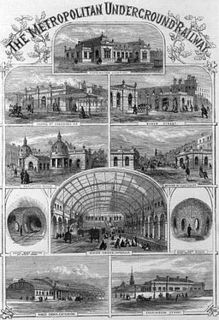
The Metropolitan Railway was a passenger and goods railway that served London from 1863 to 1933, its main line heading north-west from the capital's financial heart in the City to what were to become the Middlesex suburbs. Its first line connected the main-line railway termini at Paddington, Euston, and King's Cross to the City. The first section was built beneath the New Road using cut-and-cover between Paddington and King's Cross and in tunnel and cuttings beside Farringdon Road from King's Cross to near Smithfield, near the City. It opened to the public on 10 January 1863 with gas-lit wooden carriages hauled by steam locomotives, the world's first passenger-carrying designated underground railway.
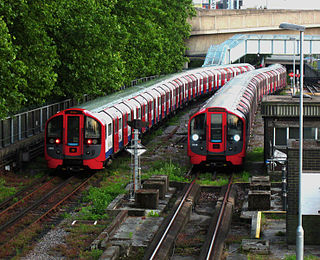
London Underground rolling stock includes the electric multiple units that run on the London Underground. The trains come in two sizes, smaller deep-tube trains and larger sub-surface trains that are of a similar size to those on British main lines. New trains are designed for the maximum number of standing passengers and for speed of access to the cars.

The Standard Stock title was applied to a variety of Tube stock built between 1923 and 1934, all of which shared the same basic characteristics, but with some detailed differences. This design is also sometimes referred to as 1923 Tube Stock, 1923 Stock, or Pre 1938 Stock. Most of the Standard Stock was built to replace the first generation of "Gate Stock" Tube trains or to provide additional trains for extensions built in the 1920s and early 1930s. Standard Stock cars consisted of motor cars, plus trailer cars and "control trailers". All were equipped with air operated sliding doors, although the guard's door on the earlier trains was a manually operated inward-opening hinged door.

The Metropolitan District Railway was a passenger railway that served London from 1868 to 1933. Established in 1864 to complete the inner circle, an underground railway in London, the first part of the line opened using gas-lit wooden carriages hauled by steam locomotives. The Metropolitan Railway operated all services until the District introduced its own trains in 1871. The railway was soon extended westwards through Earl's Court to Fulham, Richmond, Ealing and Hounslow. After completing the inner circle and reaching Whitechapel in 1884, it was extended to Upminster in Essex in 1902.
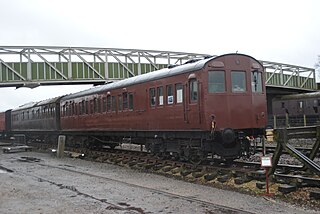
The T Stock was a series of electric trains originally built in various batches by Metropolitan-Vickers and the Birmingham Railway Carriage and Wagon Company for the Metropolitan Railway in 1927–31 for use on electric services from Baker Street and the City to Watford and Rickmansworth, though rarely some worked on the Uxbridge branch.

The London Underground R Stock electric multiple units were used on London Underground's District line from 1949 to 1983. Composed of new cars and converted Q38 Stock trailers, the cars were built and converted in three batches between 1949 and 1959. The cars were driving motors (DM) or non-driving motors (NDM), there being no unpowered trailers. The second batch, introduced in 1952, was constructed from aluminium, saving weight and one train was left unpainted as an experiment. Considered a success, trains were left unpainted or painted white or grey to match in 1963–68. Originally designed to operate in trains with six off-peak and eight cars during peak hours, the trains were reformed as fixed seven-car trains in 1971. R Stock trains were replaced by the D78 Stock and withdrawn between 1981 and 1983.

The London Underground O and P Stock electric multiple units were used on the London Underground from 1937 to 1981. O Stock trains were built for the Hammersmith & City line, using metadyne control equipment with regenerative braking, but the trains were made up entirely of motor cars and this caused technical problems with the traction supply so trailer cars were added. P Stock cars were built to run together with the O Stock cars now surplus on Metropolitan line Uxbridge services. The trains had air-operated sliding doors under control of the guard; the O Stock with controls in the cab whereas the P Stock controls in the trailing end of the motor cars. The P Stock was introduced with first class accommodation, but this was withdrawn in 1940.

An electric multiple unit (EMU) is an electric train capable of operating in multiple with other EMUs that does not have a separate locomotive, typically passenger trains with accommodation in every vehicle and a driving position at each end. The term can also be used to describe a train such as the Advanced Passenger Train that was a permanent formation with a non-driving power car. As of December 2010 two thirds of the passenger carriages in Britain are formed in EMUs.
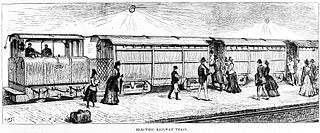
Electric locomotives were first used on the London Underground when the first deep-level tube line, the City and South London Railway (C&SLR), was opened in 1890. The first underground railways in London, the Metropolitan Railway (MR) and the District Railway (DR), used specially built steam locomotives to haul their trains through shallow tunnels which had many ventilation openings to allow steam and smoke to clear from the tunnels. It was impractical to use steam locomotives in the small unvented tubular tunnels of the deep-level lines, and the only options were rope haulage or electric locomotives.
The F Stock was built in 1920 and 1921 for the District Railway by the Metropolitan Carriage, Wagon and Finance Co. They were partly funded by the government as part of an initiative to help British industry recover from World War I. One hundred steel-bodied cars were built: 40 driving motors, 12 control trailers and 48 trailers with the first train entering service on 23 December 1920. The cars were built with manually-operated sliding doors.
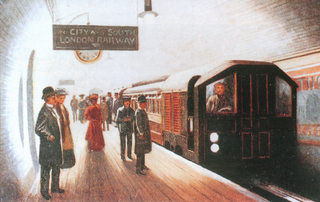
The Central London Railway Stock were electric multiple units composed of trailers that had been converted from carriages designed to be hauled by electric locomotives with new motor cars. The Central London Railway opened in 1900 with electric locomotives hauling wooden carriages, but the heavy locomotives caused vibrations that could be felt in the buildings above the route. Following investigation it was found that conversion to electric multiple units solved the problem, so new motor cars were bought and replaced all the locomotives by June 1903. Trains normally ran with six-cars, four trailers and two motor-cars, although some trailers were equipped with control equipment to allow trains to be formed with 3 cars.

The London Underground Q Stock were trains used on the District line of the London Underground. First introduced in 1938, these electric multiple units were formed from cars built between 1923 and 1935 and new purpose-built cars, and fitted with electro-pneumatic brakes and guard controlled air-operated doors. Trains were made up from cars of different ages with differing appearances, the older ones with clerestory roofs and the newer ones with flared sides. Some units were withdrawn in the early 1960s, although six- and eight-car trains remained on the District line with use gradually diminishing to peak hours only, and four car units worked the East London line until 1971.
London's Metropolitan Railway (MR) amalgamated with other underground railways, tramway companies and bus operators on 1 July 1933, to form the London Passenger Transport Board (LPTB); the MR became the Board's Metropolitan line.

Metropolitan Railway electric locomotives were used on London's Metropolitan Railway with conventional carriage stock. On the outer suburban routes an electric locomotive was used at the Baker Street end that was exchanged for a steam locomotive en route.

District Railway electric multiple units were used on London's Metropolitan District Railway after the lines were electrified in the early 20th century.

The history of the District line started in 1864 when the Metropolitan District Railway was created to create an underground 'inner circle' connecting London's railway termini. The first part of the line opened using Metropolitan Railway gas-lit wooden carriages hauled by steam locomotives. The District introduced its own trains in 1871 and was soon extended westwards through Earl's Court to Fulham, Richmond, Ealing and Hounslow. After completing the 'inner circle' and reaching Whitechapel in 1884, it was extended to Upminster in East London in 1902. To finance electrification at the beginning of the 20th century, American financier Charles Yerkes took it over and made it part of his Underground Electric Railways Company of London (UERL) group. Electric propulsion was introduced in 1905, and by the end of the year electric multiple units operated all of the services.

The London Underground opened in 1863 with gas-lit wooden carriages hauled by steam locomotives. The Metropolitan and District railways both used carriages exclusively until they electrified in the early 20th century. The District railway replaced all its carriages for electric multiple units, whereas the Metropolitan still used carriages on the outer suburban routes where an electric locomotive at the Baker Street end was exchanged for a steam locomotive en route.
















